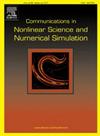Strong order one convergence of the projected Euler–Maruyama method for the Wright–Fisher model
IF 3.8
2区 数学
Q1 MATHEMATICS, APPLIED
Communications in Nonlinear Science and Numerical Simulation
Pub Date : 2025-03-12
DOI:10.1016/j.cnsns.2025.108759
引用次数: 0
Abstract
The Wright–Fisher model is a useful SDE model, and it has many applications in finance and biology. However, it does not have an analytical solution currently. In this paper, we introduce a boundary preserving numerical method, called the projected EM method, to simulate it. We first use the projected EM method for the Lamperti transformed Wright–Fisher model. Then generated numerical solutions are transformed to derive the numerical approximations for the original Wright–Fisher model. We will use a new numerical analysis method to prove uniformly bounded inverse moments of the projected EM numerical solution, and then study the strong convergence of the projected EM method. Compared to existing explicit EM methods for the Wright–Fisher model, the projected EM method is strongly convergent with order one in more general -norm and for more parameter settings.
Wright-Fisher模型的投影Euler-Maruyama方法的强一阶收敛性
Wright-Fisher模型是一个有用的SDE模型,它在金融和生物学中有许多应用。然而,目前还没有一个解析性的解决方案。本文引入了一种保持边界的数值方法,即投影电磁法,对其进行了模拟。我们首先对Lamperti变换的Wright-Fisher模型使用投影EM方法。然后对生成的数值解进行变换,得到原Wright-Fisher模型的数值近似。我们将使用一种新的数值分析方法来证明投影EM数值解的一致有界逆矩,然后研究投影EM方法的强收敛性。与现有Wright-Fisher模型的显式EM方法相比,投影EM方法在更一般的lp范数和更多参数设置下具有强收敛性,且收敛阶为1。
本文章由计算机程序翻译,如有差异,请以英文原文为准。
求助全文
约1分钟内获得全文
求助全文
来源期刊

Communications in Nonlinear Science and Numerical Simulation
MATHEMATICS, APPLIED-MATHEMATICS, INTERDISCIPLINARY APPLICATIONS
CiteScore
6.80
自引率
7.70%
发文量
378
审稿时长
78 days
期刊介绍:
The journal publishes original research findings on experimental observation, mathematical modeling, theoretical analysis and numerical simulation, for more accurate description, better prediction or novel application, of nonlinear phenomena in science and engineering. It offers a venue for researchers to make rapid exchange of ideas and techniques in nonlinear science and complexity.
The submission of manuscripts with cross-disciplinary approaches in nonlinear science and complexity is particularly encouraged.
Topics of interest:
Nonlinear differential or delay equations, Lie group analysis and asymptotic methods, Discontinuous systems, Fractals, Fractional calculus and dynamics, Nonlinear effects in quantum mechanics, Nonlinear stochastic processes, Experimental nonlinear science, Time-series and signal analysis, Computational methods and simulations in nonlinear science and engineering, Control of dynamical systems, Synchronization, Lyapunov analysis, High-dimensional chaos and turbulence, Chaos in Hamiltonian systems, Integrable systems and solitons, Collective behavior in many-body systems, Biological physics and networks, Nonlinear mechanical systems, Complex systems and complexity.
No length limitation for contributions is set, but only concisely written manuscripts are published. Brief papers are published on the basis of Rapid Communications. Discussions of previously published papers are welcome.
 求助内容:
求助内容: 应助结果提醒方式:
应助结果提醒方式:


